Humans have long imagined a future where technology is so integrated with our bodies and our interactions with the world that it can be worn.
Of all the senses, sight has always been entrusted with discovering and understanding our surroundings. And let’s face it: the idea of interacting with reality simply by looking at it, performing gestures and actions only with our gaze, continues to be deeply fascinating.
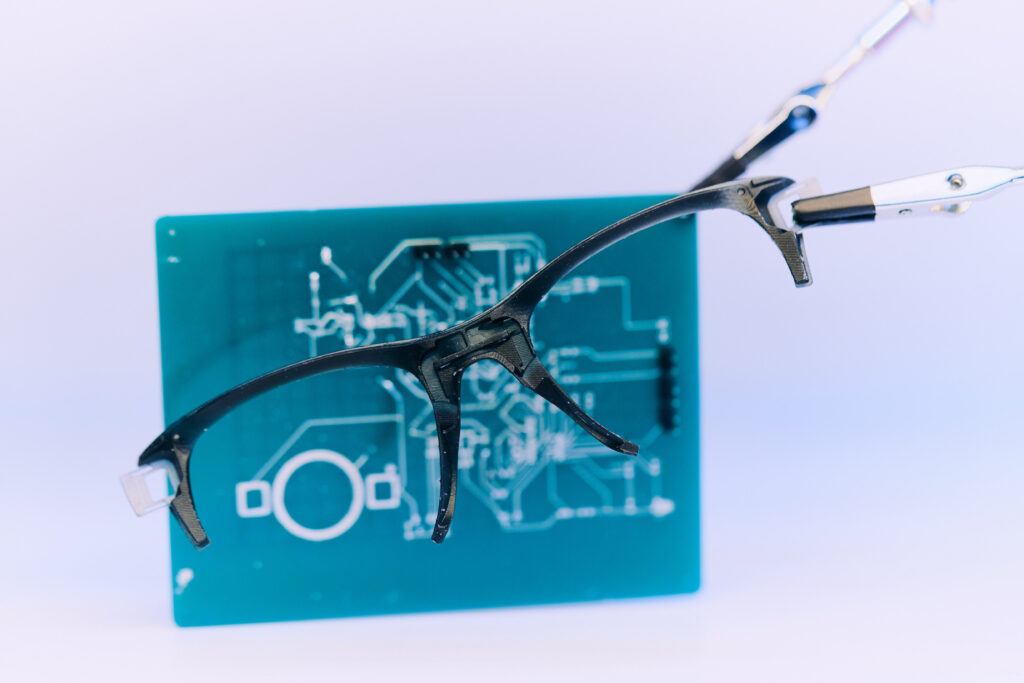
Smart eyewear, with the capacity to allow us to act on the world through the lenses, is a visionary intuition that came to life in the lines of science fiction and began to materialize in research laboratories in the second half of the twentieth century.
Today, that dream is increasingly within reach. The technologies used to design these devices are here, and they are constantly evolving. However, challenges still remain in truly turning smart eyewear into objects that can offer a natural and immersive digital experience.
It is precisely these premises that have given rise to the Smart Eyewear Lab, the joint research centre created by Politecnico di Milano and EssilorLuxottica to shape the future of smart eyewear. Here, industrial research and experimental development come together to design and implement enabling technologies that will redefine the way we see — and experience — the world. Launched in 2022, this highly innovative and groundbreaking collaboration involves over 100 researchers from industry and academia.
In the vision of the Smart Eyewear Lab, eyewear plays a strategic role, unifying sight, hearing and voice in a unique position to interact directly with our thoughts. Eyewear is therefore no longer just an accessory, but an intelligent interface to stay constantly connected and informed on culture, entertainment, sport, prevention and health.
We at Frontiere visited the Smart Eyewear Lab to tell you about it from the inside. Here, people are bringing to life something that only seemed imaginable until recently: wearable technology, connected smart glasses designed to be an integral part of our daily lives.
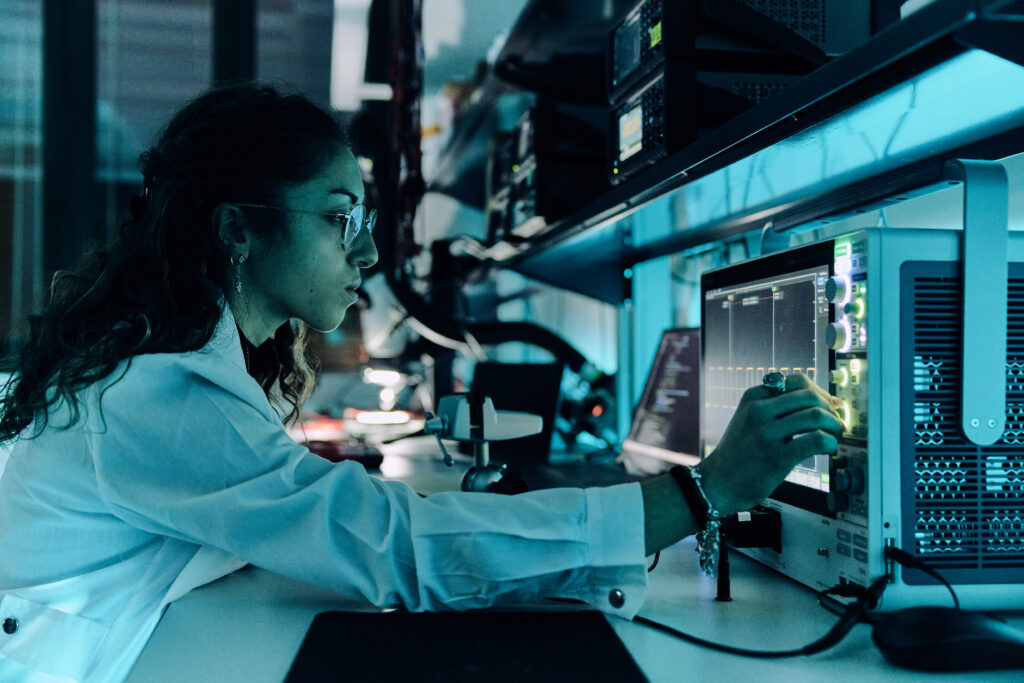
Smart Glasses: The Technology that Gives Us Superpowers
Smart eyewear looks like entirely conventional eyewear, but with a set of integrated technologies that exponentially amplifies its functions and potential. These include sensors, electronic and photonic components, microphones and speakers, all integrated so that they are virtually invisible, maintaining the appearance and elegance of an accessory where design and expression of style merge.
These glasses carry a series of features that extend the wearer’s capabilities, from augmented reality to new ways of interacting with everyday life. However, they also serve as actual sentinels of our state of health, monitoring physiological parameters and enabling timely diagnosis, improving therapeutic treatments, and revealing a predisposition for or the onset of the first signs of neurodegenerative diseases, metabolic syndromes, cardiovascular disorders and more. Ultimately, they help to improve our lifestyles, raise awareness about our state of health and, in many cases, save lives.
Perhaps the best way to describe the concept behind these smart glasses is to talk with the very people who are developing such devices.
Federico Buffa, Chief R&D, Product & Marketing Officer of EssilorLuxottica, explains:
Smart eyewear will enrich the way we perceive the world around us, giving us real superpowers. Superpowers to fully live in the moment, taking advantage of a whole new dimension whenever and wherever we need.
He highlights one fundamental point: the concept that smart eyewear is eyewear, not something that mimics it or tries to resemble it. These are real glasses, with the same design, wearability and everyday comfort. But with an extra world hidden inside. A world that you do not see, but rather experience.
All this magic is hidden in a pair of glasses, an accessory that is always the perfect extension of our personality and style, while still correcting and protecting our vision.
Technological Challenges
What are the technological challenges that still need to be addressed?
Researchers at the Smart Eyewear Lab are working on various topics to shape a new generation of smart eyewear.
The first challenge, in the words of Federico Buffa, is to make technology — from med-tech to entertainment — wearable, integrating it into an object which is is aesthetically beautiful, made according to the highest standards of production excellence while also being lightweight and pleasant to wear all day.
The second challenge relates to autonomy. For smart glasses to be truly functional, a battery must accompany the user throughout the day, without compromise.
Then there is the aspect of augmented reality: making the interaction between real world and digital content fluid, natural and adaptable to settings and spaces.
Finally, there is reliability. Technologies must work not only in the laboratory, but also and especially in the real world, in everyday situations. This requires sturdy, durable eyewear that offers high performance without sacrificing style and elegance.
Introducing us to the Smart Eyewear Lab were the project managers of the three research streams, the organizational areas of the lab activities.
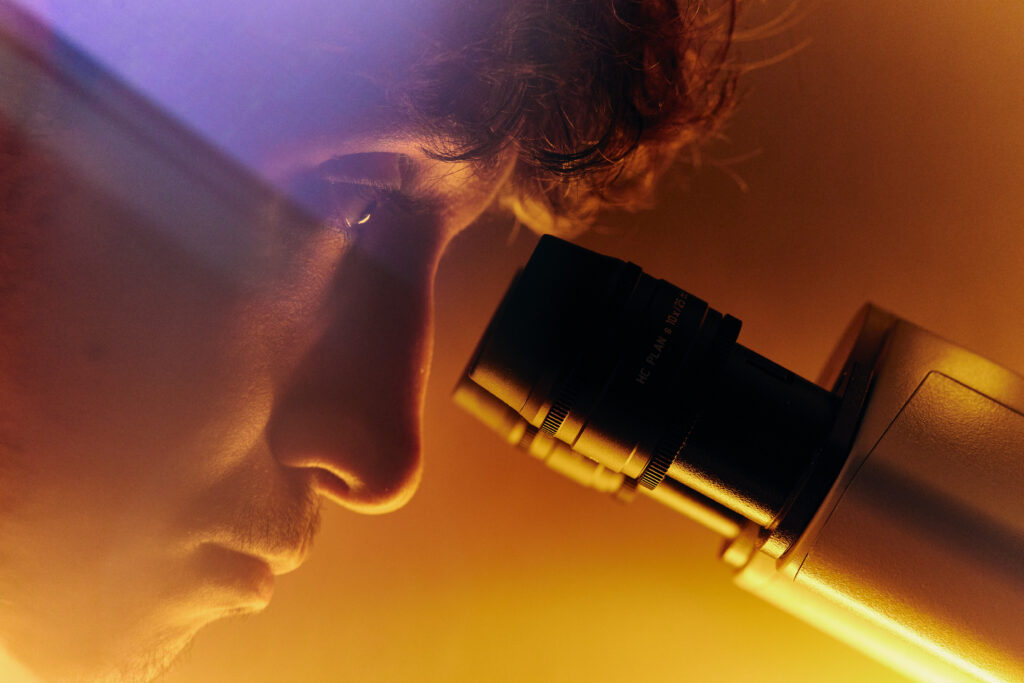
Eye Tracking
Tracking eye movements and recognizing the point of interest observed by the user is critical in designing smart glasses.
Luca Merigo explains why. After earning his doctorate in Technology for Health in Brescia and following periods of study abroad, he joined EssilorLuxottica in 2023.
To date, eye tracking devices have only been used for scientific research and neuromarketing. This means that such technology has only been used in controlled laboratory settings and its characteristics are difficult to integrate into wearable objects such as glasses. They are large, connected to cables and can annoy the user’s view.
The Smart Eyewear Lab aims to change this paradigm by developing innovative technologies that overcome such issues. The challenge for the researchers at the lab is to obtain the same type of information as current eye trackers — from monitoring to early diagnosis of diseases and disorders in relation to new metrics obtainable from eye movements — but faster and more precisely, with integration in the glasses and lower energy consumption.
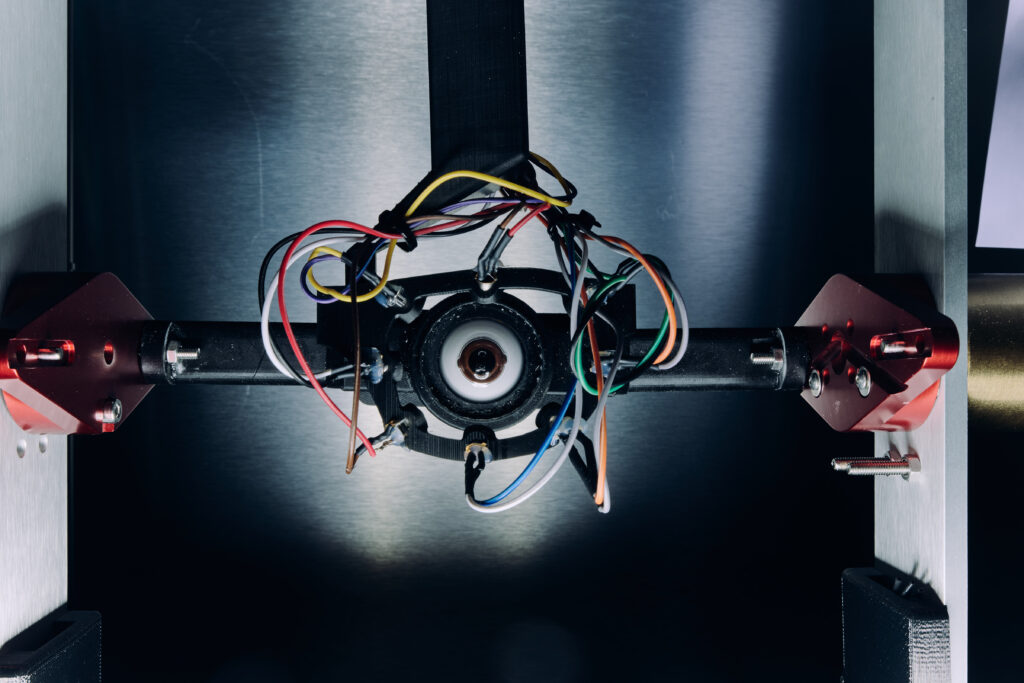
The low power technology research programme aims to integrate such technologies into the glasses, with sensors either hidden in the frame or transparent ones integrated directly into the lenses. They would be robust and suitable for everyday life and consume little energy.
For its part, the high dynamic technology programme aims to perfect technologies to capture previously untraceable eye movements through the use of artificial intelligence and new sensing technologies that mimic the behaviour of human vision.
Another challenge that lab researchers are tackling in the testing protocol programme is to define an internationally recognized validation procedure for such technologies. As a matter of fact, there is currently no protocol for measuring the performance of eye trackers; instead, each entity defines its own procedures.
Finally, research in the field of eye tracking is important because it can enable various features, allowing users to interact with augmented reality simply by directing their gaze, without using their hands. Our eyes say a lot about us — our stress level and cognitive load, for example. Eye tracking technologies therefore also provide us with valuable information that can be applied to med-tech, for monitoring and early diagnosis of diseases and disorders.
For Politecnico di Milano, this line of research is coordinated by Marco Carminati, a professor of Electronics. He has been working on low-noise electronics for sensors for twenty years. His passion for smart devices stems from optoelectronics, particularly as applied to health, and the fundamental challenge of merging sensors and embedded machine learning within very narrow space and power constraints, feeding into microelectronics.
Camera and Sensors
Diana Trojaniello tells us about integrating different types of sensors and cameras to add new features to smart glasses. She studied Biomedical Engineering and earned her PhD in Bioengineering from the University of Bologna. After a few years spent in Switzerland and the United States, she has worked for eight years in a research centre at the San Raffaele Hospital, in Milan, to develop new technologies in healthcare. She has been working with EssilorLuxottica since 2023.
Her research is divided into three distinct areas.
The first is biosensing. The goal is to provide users with the ability to monitor themselves by collecting physiological and behavioural parameters, and habits, fostering a greater awareness of their health and lifestyle.
Why collect this information through glasses? Because the face is a valuable mine of information. Not only is it the only part of the body where we can access all five senses, it also has a very high density of blood vessels, so it is easy to derive information based on cardiovascular parameters such as heartbeat and breathing rate.
The information provided by smart glasses is useful not only for the wearer, but also for caregivers, opticians and doctors, as it offers concrete support for health monitoring and management.
Furthermore, sensor research is also essential for the interaction between users and the technology integrated into the glasses. Indeed, this interaction currently occurs mainly through voice commands or gestures, implying that the user must necessarily speak or make visible gestures to control the device.
One of the research projects at the Smart Eyewear Lab aims to make these interactions imperceptible. This is the goal of the line of research focusing on the sensor systems that can interpret users’ intentions by analysing their facial expressions.
One example might be to associate winking with commands such as turning on the camera. The overall goal is to make these technologies an integral part of the wearer, almost as if they were extensions of the human body, making the interaction with smart glasses as natural and discreet as possible.
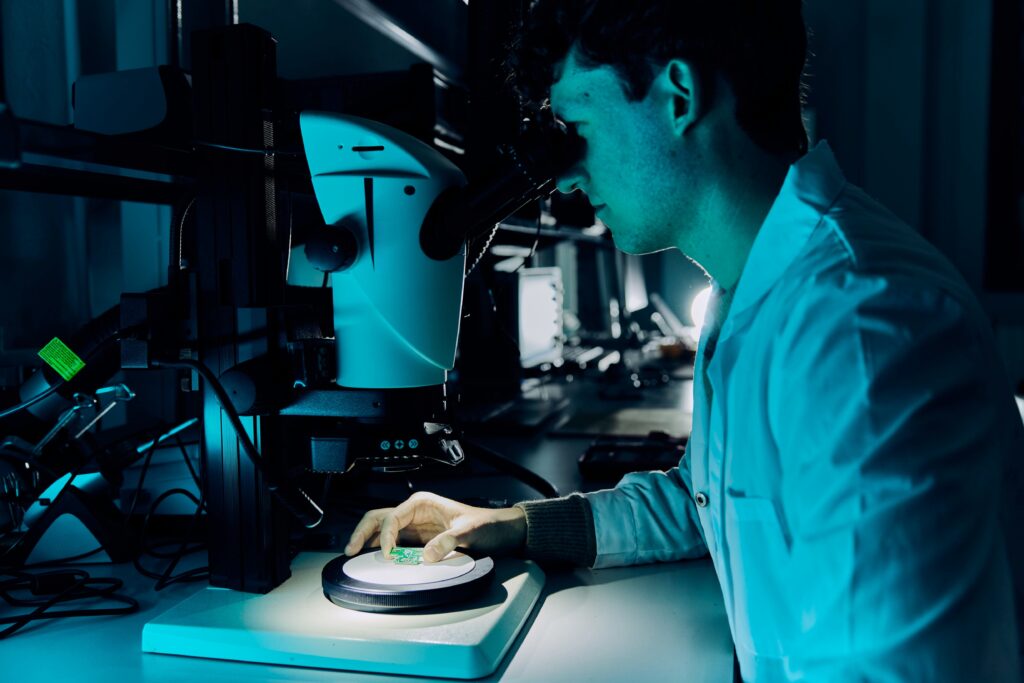
A second line of research is contextual awareness, or the ability of the device to recognize the user’s surroundings and intelligently adapt its features.
The use of sensors and cameras would allow the glasses to independently recognize the environment and situation around the subject, helping to improve the user experience.
One example could be smart glasses with augmented reality, enabling the wearer to view application notifications integrated into the user’s view of the surrounding environment. The glasses would also recognize whether the subject is immersed in a conversation with other people at a certain time and therefore disable notifications, which would also save battery power.
In other situations, the glasses might help the user with localization in an indoor environment where the GPS position is not accurate enough. One technology being studied at the Smart Eyewear Lab is Simultaneous Localization and Mapping, which leverages multiple cameras to locate the user and provide directions through complex environments such as hospitals or shopping centres.
The third line of research cuts across the first two, concerning both hardware and software optimization techniques. This relates to energy efficient sensing and processing.
These techniques are aimed at a precise goal: creating high-tech smart devices that can be worn throughout the day and operate for a long time without the need for frequent charging.
Integrating skills in electronic engineering, computer science and bioengineering, this area of research addresses issues ranging from design to integration and validation of devices, which also involves people in prototype testing. In this respect, the Politecnico di Milano Ethics Committee also comes into play, adding value in its assessment of the experimental protocols designated for this purpose.
Researchers Franco Zappa, Matteo Matteucci and Federica Villa from Politecnico di Milano’s Department of Electronics, Information and Bioengineering are working along these lines.
Franco Zappa is a professor of Electronics. His research focuses on developing microelectronic devices, particularly single photon photodetectors (SPADs) and related applications in high sensitivity 2D and 3D imaging, with application in areas such as security, adaptive optics and molecular imaging. He holds several patents for photonic detectors.
Matteo Matteucci teaches Information Processing Systems. His research activities focus on autonomous robotics and machine learning, with the aim of applying pattern recognition, robotic perception, computer vision and signal processing techniques to real, dynamic contexts.
Federica Villa is a professor of Electronics. Her research focuses on the development of electronic and optical devices and microelectronic circuits in designing portable systems for monitoring physiological parameters and ultra-weak optical signals, with application in different fields such as wearable devices, biosensing and single-photon imaging. She holds several patents for photonic imagers.
Optical Integration
Bringing augmented reality to smart glasses is the goal of the optical integration area.
This is what Anna Cesaratto, who has also been working at EssilorLuxottica since 2023, explains. After earning her PhD in Physics at Politecnico di Milano, she gained many years of experience in both academic research in the United States, and in the industry working as a consultant for vision system R&D.
The goal of this research stream is to develop a display that works as a visual interface that is constantly available to the user with its various smart features, making interaction with the digital world more immersive and immediate. Let’s imagine, for example, that we have a display built into the lens that shows our heartbeat or other data processed by smart features, such as directions to a destination.
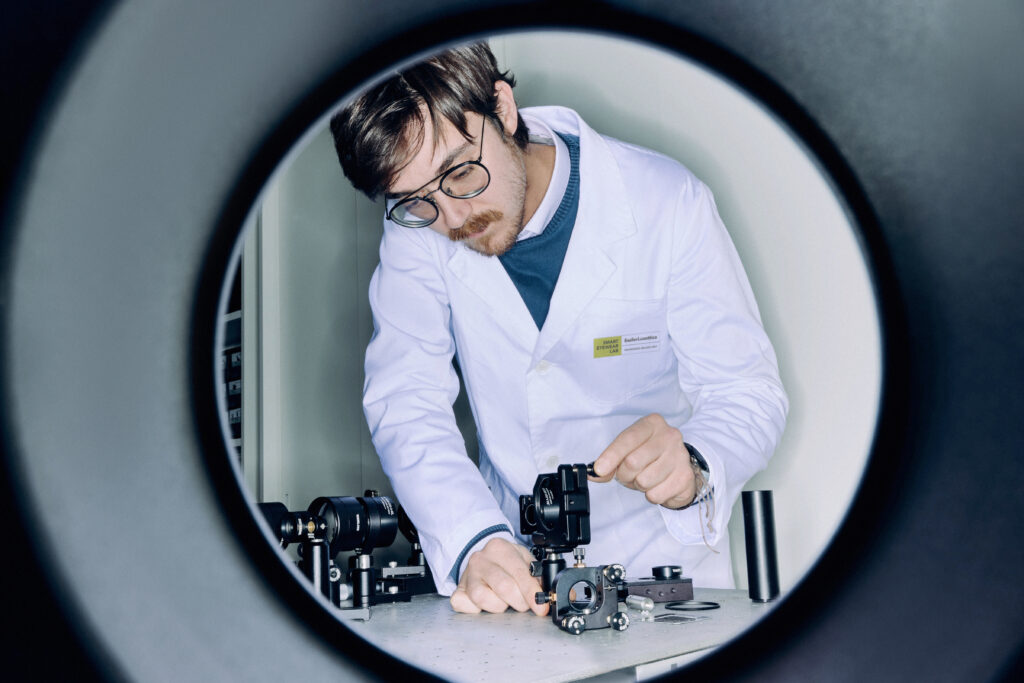
How can a notification appear directly in the user’s field of view, superimposed on the surrounding reality? This is done using a microprojector — various technologies can be used to project light — and an optical combiner, which superimposes augmented reality over the real world. In this way, with technologies integrated into the lens that direct virtual images towards the user’s eyes, both digital content and the surrounding real world can be seen through the glasses.
Augmented reality glasses already exist on the market, but the level of user comfort is still very limited. However, the research carried out at the Smart Eyewear Lab does not rely on currently available technologies, but focuses on technologies that can make the interaction more fluid and immersive.
Current technology has limitations. For example, the focus is fixed, so the projected information always appears at a certain distance, usually infinity. This is a problem, because subjects interacting with the real world constantly change their point of focus and fixed-focus projection causes discomfort due to the misalignment between real and virtual worlds. Moreover, even when virtual images are present in both lenses, they fail to reproduce a natural sense of three-dimensions.
Given that the goal is to develop glasses that can be worn every day — with comfort being of the utmost importance — the Smart Eyewear Lab is working to overcome the limits of current technology.
One possible solution is computer generated holography, a technique used to control the projection of light in three dimensions, giving the ability to project three-dimensional objects while also adjusting the depth of field of the digital content. Adding these capabilities to smart eyewear requires both the development of innovative high-efficiency algorithms and integration of the components needed to project holograms onto glasses that must remain lightweight and comfortable.
Another area of research is optical metasurfaces, nanostructured, ultra-thin artificial materials featuring a repetitive pattern, which can be designed to interact with incident light by modifying certain optical properties, such as propagation direction and phase. An important advantage is their flexibility of application against a reduced form factor, an essential aspect of smart glasses. One possible application in the field of augmented reality relates to optical combiners: metasurfaces add new functionality to the lens and direct the light generated by the microprojector into the eye.
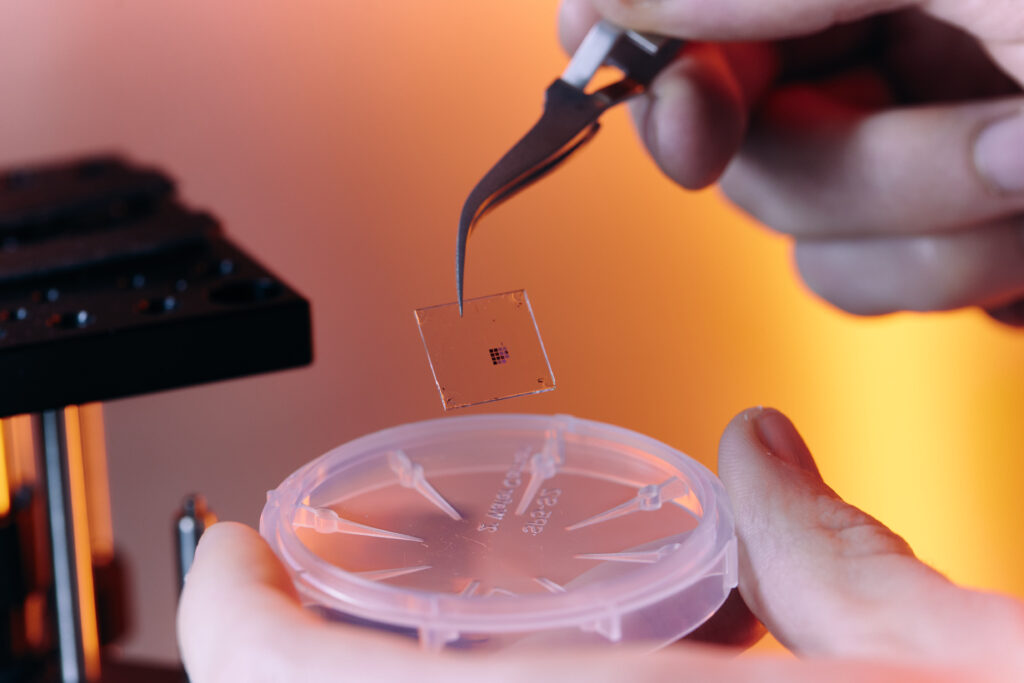
Compared to the other two streams, the scope of optical integration is to develop technologies that are radically different from the state of the art, and therefore less prepared for integration into a product: they have a lower technology readiness level. Therefore, right now we do not find assembled prototypes in these laboratories, but rather proofs of concept that, even if fully functional, primarily serve to direct research towards the most promising technologies for product development.
Giulio Cerullo, Gianluca Valentini and Paolo Biagioni from the Department of Physics are working on this research stream for Politecnico di Milano.
Giulio Cerullo is professor of Experimental Physics of Matter and Applications. His research in laser physics, nonlinear optics and matter physics has had a considerable international impact. In 2011 he received the prestigious Advanced Grant from the European Research Council to develop advanced ultrafast spectroscopy techniques.
Gianluca Valentini is professor of Experimental Physics of Matter and Applications. After working at a leading computer science company in the United States, he returned to academia, first as a CNR Researcher, then as a lecturer at Politecnico. His research concerns the applications of photonics in several fields, including biology, medicine and the science of art conservation.
Paolo Biagioni is professor of Experimental Physics of Matter and Applications. After earning his PhD in Physics and a research stint in Germany, he returned to Politecnico, where his research focuses on nano-optics, with applications in polarization control and metasurface development. He was formerly President of the Italian Society of Optics and Photonics (SIOF) and is a member of the board of the European Optical Society (EOS).
The Future
It is difficult to predict what the future holds — which of the many technologies being developed at the Smart Eyewear Lab will be the first to be integrated into a product. It is proving possible to address this important challenge, but only through the team spirit and multidisciplinary skills present at the Smart Eyewear Lab, across various research areas and between academia and industry.
